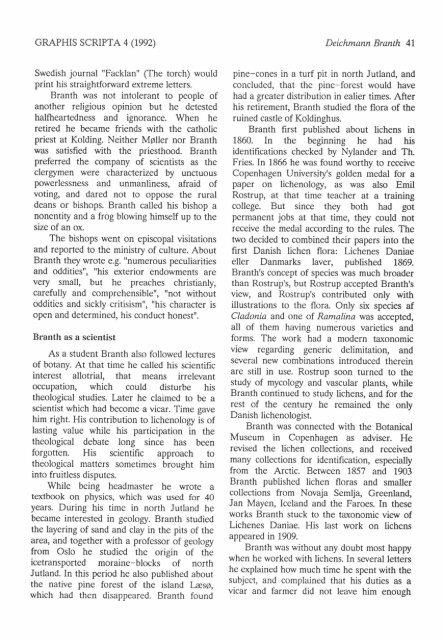GRAPHIS ScnIPTA - Universitetet i Oslo
GRAPHIS ScnIPTA - Universitetet i Oslo
GRAPHIS ScnIPTA - Universitetet i Oslo
You also want an ePaper? Increase the reach of your titles
YUMPU automatically turns print PDFs into web optimized ePapers that Google loves.
<strong>GRAPHIS</strong> SCRTPTA 4 (re92)<br />
Swedish journal "Facklan" (The torch) would<br />
print his straightforward extreme letters.<br />
Branth was not intolerant to people of<br />
another religious opinion but he detested<br />
halfteartedness and ignorance. When he<br />
retired he became friends with the catholic<br />
priest at Kolding. Neither Mgller nor Branth<br />
was satisfied with the priesthood. Branth<br />
preferred the company of scientists as the<br />
clergymen were characterized by unctuous<br />
powerlessness and unmanliness, afraid of<br />
voting, and dared not to oppose the rural<br />
deans or bishops. Branth called his bishop a<br />
nonentity and a frog blowing himself up to the<br />
size of an ox.<br />
The bishops went on episcopal visitations<br />
and reported to the ministry of culture. About<br />
Branth they wrote e.g. "numerous peculiarities<br />
and oddities", "his exterior endowments are<br />
very small, but he preaches christianly,<br />
carefully and comprehensible", "not without<br />
oddities and sickly critisism", "his character is<br />
open and determined, his conduct honest".<br />
Branth as a scientist<br />
As a student Branth also followed lectures<br />
of botany. At that time he called his scientific<br />
interest allotrial, that means irrelevant<br />
occupation, which could disturbe his<br />
theological studies. Later he claimed to be a<br />
scientist which had become a vicar. Time gave<br />
him right. His contribution to lichenology is of<br />
lasting value while his participation in the<br />
theological debate long since has been<br />
forgotten. His scientific approach to<br />
theological matters sometimes brought him<br />
into fruitless disputes.<br />
While being headmaster he wrote a<br />
textbook on physics, which was used for 40<br />
years. During his time in north Jutland he<br />
became interested in geology. Branth studied<br />
the layering of sand and clay in the pits of the<br />
area, and together with a professor of geology<br />
from <strong>Oslo</strong> he studied ttre origin bf tfie<br />
icetransported moraine-blocks of north<br />
Jutland. In this period he also published about<br />
the native pine forest of the island La;sg,<br />
which had then disappeared. Branth found<br />
Deichmann Branth 4l<br />
pine-cones in a turf pit in north Jutland, and<br />
concluded, that the pine-forest would have<br />
had a greater distribution in ealier times. After<br />
his retirement, Branth studied the flora of the<br />
ruined castle of Koldinghus.<br />
Branth first published about lichens in<br />
1860. In the beginning he had his<br />
identifications checked by Nylander and Th.<br />
Fries. In 1866 he was found worthy to receive<br />
Copenhagen University's golden medal for a<br />
paper on lichenology, as was also Emil<br />
Rostrup, Bt that time teacher at a training<br />
college. But since they both had got<br />
permanent jobs at that time, they could not<br />
receive the medal according to the rules. The<br />
two decided to combined their papers into the<br />
first Danish lichen flora: Lichenes Daniae<br />
eller Danmarks laver, published L869.<br />
Branth's concept of species was much broader<br />
than Rostrup's, but Rostrup accepted Branth's<br />
view, and Rostrup's contributed only with<br />
illustrations to the flora. Only six species af<br />
Cladonia and one of Ramalina was accepted,<br />
all of them having numerous varieties and<br />
forms. The work had a modern ta

















